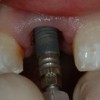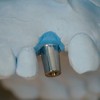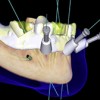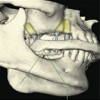Can edentulous patients be permitted to wear dentures after completion of high dose radiation to the denture foundation area? Yes! Almost all patients will be able to use complete dentures with little or no risk of precipitating an osteoradionecrosis if certain precautions are taken. The factors important to consider are the radiation treatment volume, dose delivered to key portions of the denture bearing surfaces, the quality of the denture foundation area, past experience of the patient and other factors. This program discusses these issues in detail as well as the methods used to fabricate dentures that are unique for this group of patients.
1. 7. Complete Dentures for Irradiated Patients John Beumer III DDS, MS Distinguished Professor Emeritus Division of Advanced Prosthodontics, Biomaterials and Hospital Dentistry, UCLA All rights reserved. This program of instruction is covered by copyright ©. No part of this program of instruction may be reproduced, recorded, or transmitted, by any means, electronic, digital, photographic, mechanical, etc., or by any information storage or retrieval system, without prior permission of the authors.
2. Table of Contents Risk of bone necrosis Use of silicone soft liners Placement of dentures – timing Dentures and pre-existing bone necrosis Morbidity – ORN secondary to denture use Soft tissue necrosis and dentures Prosthodontic procedures History and examination Impressions VDO and CR Occlusal forms Delivery and post-insertion care
3. Prosthetic Management Edentulous Patients Can edentulous patients be permitted to wear dentures after completion of high dose radiotherapy for oral cancer?Yes!! Almost all patients will be able to use completedentures with little or no risk of precipitating anosteoradionecrosis if certain precautions are taken.
4. Can existing dentures be reinserted after completion of RT?Dentures can reinserted following completion of RT and theresolution of mucositis in most patients. One factor to consideris the percentage of the bearing surface within the gross tumorvolume because these tissues will receive a very high dose. For most patients with soft palate or nasopharyngeal neoplasms, the dose delivered to the denture bearing surfaces of the mandible is not clinically significant whether or not CRT or IMRT is employed Experienced complete denture wearers usually have developed the necessary neuromuscular coordination necessary for successful function with dentures and are less likely to exhibit tongue or cheek biting.
5. Can existing dentures be reinserted after completion of RT? However when tumors of the oral tongue and floor of mouth are irradiated with CRT or IMRT, large portions of the mandibular bearing surface may be within the gross tumor volume and exposed to high doses and this should be taken into consideration. Therefore, in some patients it may not be appropriate for the patient to continue to wear their existing dentures The following risk factors affect the decision: The condition of the bearing surface mucosa Boney contours of the alveolar ridge Compliance of the patient ChemoRT magnifies the risk of complications associated with denture use
6. What factors determine the risk of bone necrosis from denture use? Dose and volume delivered to the mandibular denture bearing surfaces Boney contours of the mandibular denture bearing surfaces Quality of the denture bearing mucosa in the mandible Neuromuscular control of the patient Past experience with dentures
7. Prosthetic Management Edentulous Patients What is the risk of bone necrosis from denture use? Two Groups to Consider Patients edentulous prior to radiation therapy with experience with dentures. Patients undergoing preradiation or postradiation extraction with dentures fitted after completion of radiation.The former are at low risk of ORN from the of use dentures whilethe latter have some risk although it is minimal.
8. Source: Beumer J et al, J Prosthet Dent, 1976 Patients Edentulous Prior to Therapy• Number of patients 92• Full lower dentures in the field 87• Full upper dentures in the field 72• Previous experience with removable prostheses (pts) 84• Time interval, therapy to delivery (mths) • Average 15.4 • Range 2-112• Followup after delivery (mths) • Average 20.9 • Range 6-114• Osteoradionecrosis secondary to dentures 0• Soft tissue necroses (patients) 6
9. Source: Beumer J et al, J Prosthet Dent, 1976Denture use in patients dentulous prior to therapy requiring extractions in the radiation fields Number of patients 36 Full lower dentures 31 Full upper dentures 30 Soft tissue necrosis 0 Previous experience with RPD’s 18Dentures for patients with pretreatment extractions Patients 23 Osteos secondary to dentures (pts) 2 Time interval, therapy to delivery (ave, mths) 22.2 Followup after delivery (months) Average 19.2 Range 3-92
10. Dentures for patients with post radiation extractionsPatients 16Osteos secondary to dentures (pts) 3Time interval, therapy to delivery (ave, mths) 26.1Time interval, extraction to delivery (months ) Average 11.8 Range 2-45 Source: Beumer J et al, J Prosthet Dent, 1976
11. Silicone LinersContraindicated because: Silicones exhibit decreased wetability. This, combined with reduced salivary flow results in increased friction at the denture-mucosa interface during function. The silicones deteriorate rapidly secondary to fungus infestation. It is very difficult to adjust. Eight of 25 patients fitted with silicone liners developed soft tissue necrosis (Daley and Drane, 1972)
12. Placement of Dentures – TimingPatients edentulous prior to the tumor diagnosis whoare experienced denture wearers New dentures can be made or existing dentures reinserted as soon as the mucositis has resolved. If the tumor site lies within the area of a denture extension area or the bearing surfaces, the denture should be checked with pressure indicating paste (PIP) and disclosing wax prior to reinsertion.Patients dentulous prior to undergoing preradiationor postradiation extractions Denture bearing surfaces should be carefully examined for contour irregularity, telangiectasia, and scar before proceeding with denture fabrication. Some such patients qualify immediately, others may never be good candidates for mandibular dentures.
13. Denture use and preexisting osteoradionecrosisPermitted in selected patients When the bone exposure is confined within the zone of attached keratinized mucosa (circle). When the denture can be generously relieved at and around the area of bone exposure.Not permitted When the bone exposure is extends beyond the zone of attached keratinized mucosa or shows signs of worsening (arrow). In noncompliant patients.
14. Morbidity Osteoradionecrosis Secondary to Dentures Most ORN’s secondary to denture irritation resolve with conservative treatment and generally do not require surgical resection and/or hyperbaric oxygen. Daley and Drane (l972) – Four out of five healed with conservative measures. Beumer et al (l984) – Seven of eight resolved with conservative treatment. Why so successful?Post radiation the periosteum is theprimary blood supplyMost ORN’s in edentulous patientspresent short of the mucogingival junction.The gingival fibers help secure theperiosteum to the underlying bonepreventing spread of the exposure.
15. Soft tissue necrosis and dentures In some patients edema of the tongue and buccal mucosa is prominent and tongue and cheek biting is not uncommon. Occlusal trauma may lead to a soft tissue necrosis, particularly in patients whose tongue lesions were treated with brachytherapy.This patient was treated with combination external beam and brachytherapy. The dose delivered to the lateral tongue was in excess of 8000 cGy. Occlusal trauma led to a soft tissue necrosis.Exam often reveals in such cases that the denture teeth are excessively worn with insufficient horizontal over lap.In such patients dentures should be remade paying particular attention to thehorizontal overlap of the posterior teeth.
16. Positioning posterior denture teeth – Irradiated patients In arranging posterior teeth careful attention should be directed toward attaining proper buccal horizontal overlap. Some clinicians use only 3 posterior teeth, in order to avoid trauma to the posterior buccal mucosa. By properly centering the lingual cusps of the maxillary teeth over the central grooves of the mandibular teeth the horizontal overlap should be ideal and should be sufficient to prevent biting of the cheek and corner of the mouth. Note that only 3 posterior Horizontal teeth have been used in this setup overlap
17. Soft tissue necrosis and dentures Treatment consists of establishing the diagnosis, removal of the lower denture and close followup. In severe cases some clinicians believe that a course of HBO will accelerate healing. Pentoxifylline, a fibrinolyitic agent which enhances blood flow in ischemic tissues, has also been proposed as a means to facilitate mucosalization (Dion et al, 1989).
18. Prosthodontic ProceduresHistory and exam findings of unique importance Radiotherapy data Condition of oral mucous membranes Contours of the bony bearing surfaces, presence of bony undercuts Salivary flow rates Trismus Scarring at the tumor site
19. History Radiotherapy data Modality CRT vs IMRT Dose to denture bearing surfaces Previous denture use History of successful use of complete dentures prior to therapy is an accurate indicator of future success Psychosocial issuesThe patient’s attitude towards himself/herself and the disease is of primeimportance. Many are emotionally distraught over the uncertainty regarding cureand the morbidity inflicted by their radiation treatment. These attitudes should beanticipated and psychosocial counseling provided when appropriate . Anuncooperative, poorly motivated patient, is a poor candidate for postradiationdenture service.
20. History of Denture Use Edentulous patients with a history of multiple complaints and difficulties associated with their dentures prior to radiation treatment may indicate an added risk factor for complications with dentures post radiation. This possibility must be discussed frankly with the patient prior to prosthetic treatment. In addition the patient must be well informed of the risks associated with the use of dentures. Since most complaints are associated with mandibular complete dentures, rarely will these patients be pleased with their new mandibular denture.
21. Exam findingsCondition of oral mucous membranes Telangiectasia, mucosal atrophy and bearing surface boney contours This patient presents with both telangiectasia of the bearing surface mucosa and irregular boney bearing surfaces. In such instances the denture bearing surface epithelium may be only 5-6 cell layers thick.
22. Exam findings Telangiectasia and mucosal atrophy – mandibleThese two patients were treated with CRT with opposedmandibular fields and the dose to the mandibular body was 70Gy. Exam revealed mucosal atrophy and telangiectasia on the denture foundation surfaces. Both patients are poor candidates for mandibular dentures because of the high risk of mucosal perforation andosteoradionecrosis. However, a maxillary denture can be wornwith little or no risk to the patient.
23. Exam Findings Telangiectasia and mucosal atrophy – Maxilla A BThese two patients were treated with CRT via posterior lateral facial fields. Both exhibit telangiectasia and mucosal atrophy but not on the bearing surfaces.In patient “A” the fields terminated anteriorly at the junction of the hard and soft palate. Little of the mandibular bearing surfaces were in theradiation field. fieldIn patient “B” the telangiectasia and scarring was confined to the tumor site and did not extend to the mandibular denture bearing surfaces.Based on these and other factors both patients were considered candidates for maxillary and mandibular complete dentures.
24. Exam Findings Telangiectasia and mucosal atrophy – Maxilla In this patient the maxilla was exposed to in excess of 68 Gy. Note the telangiectasia of the palatal mucosa, the buccal mucosa and the residual portion of the soft palate. A maxillary prosthesis in indicated because the risk of osteoradionecrosis (ORN) is insignificant but if such changes were noted on the bearing surfaces of the mandible a complete denture would be contraindicated because of the risk of mucosal perforation and ORN.
25. Exam Findings –Bony ContoursContours of the bony bearing surfaces and presence of bony undercuts Irregular contours on the mandibular bearing surface may contraindicate the fabrication of a lower denture if these surfaces are within the gross tumor volume and the dosage is high (above 65 Gy).During function the mandibular denture slips and slides over the mucosa during function and prior to closure the tongue seats the denture on the bearing surfaces. If the denture is not properly seated when the closure occurs mucosal injury can result.
26. Exam Findings –Bony Contours Contours of the bony bearing surfaces and presence of bony undercuts Irregular contours on the mandibular bearing surface may contraindicate the fabrication of a lower denture if these surfaces are within the gross tumor volume and the dosage is high (above 65 Gy).This patient would be a poor candidate for a lower denture. He was treatedwith CRT with opposed mandibular fields for a lateral tongue lesion. Thedose delivered was 66 Gy. The irregular bearing surfaces combined withsignificant reduction in salivary flow would predispose this patient to mucosalperforations and osteoradionecrosis.
27. Exam Findings –Bony Contours Contours of the bony bearing surfaces and presence of bony undercutsIf the gross tumor volume was high and posterior, limiting the dose to theseirregular bony surfaces to less than 5500 cGy, dentures could be worn safelyand the ridge irregularities expected to remodel.
28. Exam Findings Posterior – Palatal Seal Area If the posterior palatine salivary glands are heavily irradiated the palatine glands and the adjacent tissues become fibrotic As a result the posterior palatal seal area becomes less displaceable and combined with reduced salivary flow peripheral seal becomes more difficult to attain
29. Exam findings – Salivary flow ratesConsequences of reduced flow rates: Compromise tolerance of dentures particularly the mandibular denture Compromised peripheral seal of the maxillary denture Increases the risk of tissue irritation particularly in the mandible because: Its reduced bearing surfaces as compared to the maxilla The mandibular denture slips and slides over the bearing surface during function.
30. Exam findings – Trismus Most commonly seen in patients with tumors of the soft palate, tonsil and nasopharynx where the muscles of mastication receive high dose levels (about 10-50% in such patients) Made significantly worse by concomitant chemotherapy Trismusmay require the reduction of the vertical dimension of occlusion in order to facilitate entrance of the bolus
31. Exam Findings – Scarring Scarring at the tumor site within the denture foundation area or at the periphery of the dentureThis patient is a good candidate for complete dentures but caremust be taken to avoid overextension of the denture adjacent tothe scar associated with the tumor site. A mucosal perforation inthis area would probably lead to an osteoradionecrosis.
32. Compliance Does the patient continue to abuse tobacco and alcohol? Will he/she leave out the dentures at night? Can you rely on the patient calling you when he/she develops a sore area? Do they understand the risk of bone necrosis? If the patient does not understand the importance of the above or is noncompliant, upper dentures may be worn but use of lower dentures should be discouraged. discouraged
33. Exam FindingsAny condition which compromises the prosthetic prognosis innonirradiated patients assumes added significance in irradiatedpatients. The clinician should examine the denture foundation area thoroughly for undercuts, tori, high tissue attachments, enlarged maxillary tuberosities, flabby and redundant tissue, lack of attached gingiva, retruded tongue position, unfavorable floor of mouth contours and abnormal jaw relationships. For example, mandibular ridges such as these with severe bilateral undercuts or excessive ridge resorption with little attached keratinized mucosa are poor candidates for complete denture service following radiation therapy.
34. Prosthodontic ProceduresImpressions Border molding Border mold with a low fusing compound* with custom trays Develop maximum extensions but avoid overextension at the tumor site Do not attempt to displace the floor of the mouth to obtain peripheral seal*Bite compound, G.C. Dental Industrial Corp. Chicago, Tokyo
35. Prosthodontic ProceduresImpressions Border molding Efforts to develop the lingual flange should be directed toward gaining stability rather than retention. Edema of the tongue and floor of mouth, which is particularly prominent if the patient has undergone a radical neck dissection, will occasionally be sufficiently extensive to compromise tongue space, compromise floor of mouth posture and limit the extent of the lingual flange.*Bite compound, G.C. Dental Industrial Corp. Chicago, Tokyo
36. Prosthodontic ProceduresImpressions Wash materials Polysulfide Thermoplastic wax If wax is used to refine the impression, an occlusal index engaging the opposing denture must be incorporated within the tray
37. Facebow transfer record A facebow transfer record is used to mount the maxillary cast on the articulator.
38. Establishing VDR and VDO VDO Determined in the usual fashion The VDO is closed only in patients with severe trismus so as to facilitate easy entrance of the bolus
39. Centric relation records aremade in the usual manner.
40. Occlusal forms It is not possible with the information at hand to make assumptions relative to the efficacy of any particular occlusal scheme available in the construction of complete dentures for irradiated patients. In our review of 128 patients (Beumer et al, 1976) both anatomic teeth and non anatomic forms with full balance were employed. On a theoretical basis, however, I have come to favor lingualized or monoplane occlusal schemes with balance facilitated with posteriorly situated balancing ramps. The literature seems to indicate that less horizontal force is generated with a nonanatomic occlusal scheme (Frechette, 1955; Kydd, 1956; Sharry et al., 1960; Swoope and Kydd, 1966) and this assumption, if true, would be of obvious advantage to irradiated patients.
41. Occlusal formsLingualized with Nonanatomic withbilateral balance balancing ramps Selection based on the usual criteria Coordination of the patient Bony contours of the ridges Tongue position and floor of mouth posture Jaw relations Tooth selection is not based on the fact that the patient has been irradiated.
42. Lingualized Occlusion Indications for use Advantages High esthetic demands Good esthetics Severe mandibular ridge Freedom of non-anatomic atrophy teeth Displaceable supporting Potential for bilateral tissues balance Malocclusion Centralizes vertical forces Previous successful Minimizes tipping forces denture with Lingualized Facilitates bolus Occlusion penetration (mortar and pestle effect)
43. Delivery and Post-Insertion Care Pressure indicating paste Disclosing wax Clinical remount 24 and 48 hour followup Leave dentures out at night Educate the patient Risk Morbidity
44. Adjusting the Denture Base with pressure indicating paste (PIP) PIP the mandibular denture Use smooth even brush strokes Carefully insert denture so as to avoid wiping off PIP in undercut areas Adjust as necessaryPay particular attention to themylohyoid region for mucosalperforations in this region canlead to an osteoradionecrosis.
45. Adjusting the denture borders with disclosing wax Examples of commonly overextended areas Pay particular attention to the site of the tumor particularly if it is located on the denture border These flanges are too thick These flanges are too long
46. Clinical RemountPurpose To Correct for the fact that: Adjusted denture bases seat more accurately than record bases Accommodate for errors made during the making of centric relation records “Measure twice, cut once” once
47. Clinical RemountSeat the posterior palatal seal Placetwo cotton rolls between the posterior teeth and have the patient bite down for 5 minutes.
48. Clinical RemountMake centric relation record and prove the record Carry to mouth and have the patient close in centric relation just short of tooth contact. While making the record, instruct the patient to retrude and elevate the tongue. This will ensure that the condyles are properly seated while making the record.
49. Clinical RemountRemove the record. Chill in cold water and trim so that onlythe cusp tip indentations remain. Trim the buccal side sothat the seating of the dentures can be visually checked.
50. Clinical RemountReturn the record to the mouth and recheck the record.Contact should be equal and simultaneous bilaterally. If notrepeat the record. Observe the maxillary denture as the patientcloses. If the denture moves during closure repeat the record.
51. Clinical RemountUsing remount casts the dentures are remounted on thearticulator. Make sure to lock the condyles in centric whileremounting the dentures. The maxillary remount cast had beenmounted prior to removing the maxillary denture from themaster cast.
52. Clinical RemountBegin by equilibrating in centric relation. If your originalCentric Relation record was correct, little or noadjustment will be necessary.
53. Clinical RemountMake a protrusive record. Instruct thepatient to bring their mandible forward8-10 mm when making the record.
54. Clinical RemountProtrusive record Transfer the record to the articulator. Hold the upper member of the articulator down into the record and adjust the condylar inclination.
55. Clinical Remount – Lingualized Occlusion Balancing Working side side Mandibular movementCheck excursions. If necessary, adjust the occlusion to restore bilateral balance.
56. Delivery Instructions and Followup The care after delivery of dentures is critical and requires an understanding patient to avoid untoward complications. The patient is given an instruction sheet detailing possible problems and precautions. Instructions concerning removal of the dentures if soreness develops, the necessity for periodic return visits, and the initial limited use of the prosthesis for mastication are provided. Complete dentures should never be worn while sleeping. During the first week, 24 hour, and 48 hour recall appointments are recommended regardless of how well the patient is tolerating his/her dentures. At the end of the adjustment period, the patient is required to return four times during the first year. If the patient continues to present without complications, the interval between visits may be lengthened during succeeding years.
57. Visit ffofr.org for hundreds of additional lectures on Complete Dentures, Implant Dentistry, Removable Partial Dentures, Esthetic Dentistry and Maxillofacial Prosthetics. The lectures are free. Our objective is to create the best and most comprehensive online programs of instruction in Prosthodontics
58. References Beumer J, Curtis T, Morrish R. (1976) Radiation complications in edentulous patients. J Prosthet Dent 36:193-203. Griern M, Robinson J., Barnhart G. (1964) The uses of a soft denture base material in management of the postradiation denture problems. Radiology 82:320-1. Daly T, Drane J. (1972) Management of dental problems in irradiated patients. Houston, Texas (Publication of the University of Texas). Rahn A, Matalon V, Drane J. (1968) Prosthetic evaluation of patients who have received irradiation to the head and neck regions. J Prosth Dent 19:174-9. Krajicek D. (1969) Oral radiation in prosthodontics. J Amer Dent Assoc. 78:320-22. King R, Elzay R, Prints. (1968) Effects of ionizing radiation in the human oral cavity and oropharynx. Radiology 91:990. Frechette A. (1955) Masticatory forces associated with the use of various types of artificial teeth. J Prosthet Dent 5:252-67. Kydd W. (1956) Complete denture base deformation with varied occlusal tooth form. J Prosthet Dent 6:714-18. Sharry J, Askew H, Hoyer H. (1960) Influence of artificial tooth forms on bone deformation beneath complete dentures. J Dent Res 39:253. Swoope C, Kydd W. (1966) The effect of cusp form and occlusal surface area on denture base deformation. J Prosthet Dent 16:34-43
59. The End


 Single Tooth Defects in Posterior Quadrants
Single Tooth Defects in Posterior Quadrants
 Cement Retention vs Screw Retention
Cement Retention vs Screw Retention
 Computer Guided Treatment Planning and Surgery
Computer Guided Treatment Planning and Surgery
 Angled Implants
Angled Implants
